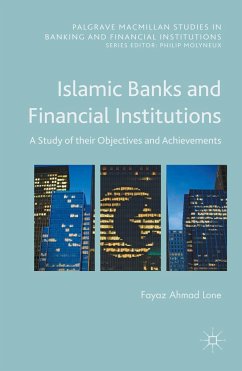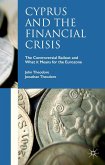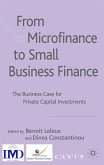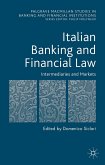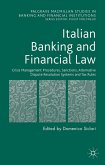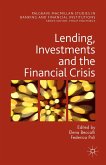Fayaz Ahmad Lone
Islamic Banks and Financial Institutions
A Study of Their Objectives and Achievements
Fayaz Ahmad Lone
Islamic Banks and Financial Institutions
A Study of Their Objectives and Achievements
- Gebundenes Buch
- Merkliste
- Auf die Merkliste
- Bewerten Bewerten
- Teilen
- Produkt teilen
- Produkterinnerung
- Produkterinnerung
This book is a study of the objectives of Islamic Finance in the modern banking space and offers insight into the effects of changes and developments occurring in Islamic banking products and services.
Andere Kunden interessierten sich auch für
![Ethics in Banking Ethics in Banking]() Jes VillaEthics in Banking112,99 €
Jes VillaEthics in Banking112,99 €![Cyprus and the Financial Crisis Cyprus and the Financial Crisis]() John TheodoreCyprus and the Financial Crisis75,99 €
John TheodoreCyprus and the Financial Crisis75,99 €![From Microfinance to Small Business Finance From Microfinance to Small Business Finance]() From Microfinance to Small Business Finance75,99 €
From Microfinance to Small Business Finance75,99 €![Italian Banking and Financial Law: Intermediaries and Markets Italian Banking and Financial Law: Intermediaries and Markets]() Italian Banking and Financial Law: Intermediaries and Markets104,99 €
Italian Banking and Financial Law: Intermediaries and Markets104,99 €![Italian Banking and Financial Law: Crisis Management Procedures, Sanctions, Alternative Dispute Resolution Systems and Tax Rules Italian Banking and Financial Law: Crisis Management Procedures, Sanctions, Alternative Dispute Resolution Systems and Tax Rules]() Italian Banking and Financial Law: Crisis Management Procedures, Sanctions, Alternative Dispute Resolution Systems and Tax Rules75,99 €
Italian Banking and Financial Law: Crisis Management Procedures, Sanctions, Alternative Dispute Resolution Systems and Tax Rules75,99 €![Lending, Investments and the Financial Crisis Lending, Investments and the Financial Crisis]() Lending, Investments and the Financial Crisis75,99 €
Lending, Investments and the Financial Crisis75,99 €![Social Capital and Risk Sharing Social Capital and Risk Sharing]() Abbas MirakhorSocial Capital and Risk Sharing75,99 €
Abbas MirakhorSocial Capital and Risk Sharing75,99 €-
-
-
This book is a study of the objectives of Islamic Finance in the modern banking space and offers insight into the effects of changes and developments occurring in Islamic banking products and services.
Produktdetails
- Produktdetails
- Palgrave Macmillan Studies in Banking and Financial Institutions
- Verlag: Palgrave Macmillan / Palgrave Macmillan UK / Springer Palgrave Macmillan
- Artikelnr. des Verlages: 978-1-137-51565-0
- 1st ed. 2016
- Seitenzahl: 201
- Erscheinungstermin: 29. November 2015
- Englisch
- Abmessung: 216mm x 140mm x 14mm
- Gewicht: 404g
- ISBN-13: 9781137515650
- ISBN-10: 1137515651
- Artikelnr.: 42775192
- Herstellerkennzeichnung
- Libri GmbH
- Europaallee 1
- 36244 Bad Hersfeld
- gpsr@libri.de
- Palgrave Macmillan Studies in Banking and Financial Institutions
- Verlag: Palgrave Macmillan / Palgrave Macmillan UK / Springer Palgrave Macmillan
- Artikelnr. des Verlages: 978-1-137-51565-0
- 1st ed. 2016
- Seitenzahl: 201
- Erscheinungstermin: 29. November 2015
- Englisch
- Abmessung: 216mm x 140mm x 14mm
- Gewicht: 404g
- ISBN-13: 9781137515650
- ISBN-10: 1137515651
- Artikelnr.: 42775192
- Herstellerkennzeichnung
- Libri GmbH
- Europaallee 1
- 36244 Bad Hersfeld
- gpsr@libri.de
Dr. Fayaz Ahmad Lone is Assistant Professor at the College of Business Administration in Salman Bin Abdulaziz University, Al-Kharj, Saudi Arabia. Dr. Fayaz Ahmad obtained a PhD in Islamic Finance from Aligarh Muslim University, India, and a Master's Degree from the University of Kashmir, India. He has published more than a dozen research papers on Islamic finance in International and National Journals and has presented a large number of papers at international conferences.
"PART I: ISLAMIC FINANCE: AN INTRODUCTION
1.1. Islamic Finance
1.2. Conventional Financial System Vs Islamic Financial System
1.3. Islamic Banks Vs Conventional Banks
1.4. Components of Islamic Finance
1.4.1. Banks
1.4.1.1. Investment and Investment Management
1.4.1.2. General Banking Services
1.4.1.3. Social Services
1.4.2. Equity and Capital Market
1.4.3. Takaful
1.4.4. Waqf and Zakat
1.5. Operating Structure of Islamic Banks
1.5.1. Window Model
1.5.2. Branches
1.5.3. Subsidiaries
1.5.4. Full-Fledged Banks
1.6. Products and Services of Islamic Finance
1.6.1. Murabahah (Cost Plus Financing)
1.6.2. Mudarabah (Sleeping Partnership)
1.6.3. Musharakah (Partnership Financing)
1.6.4. Ijara (Leasing)
1.6.5. Salam
1.6.6. Takaful (Insurance)
1.6.7. Sukak (Bond)
1.7. Why Islamic Finance is Growing
1.7.1. Fast and Steady Growth
1.7.2. Green Financing Platform
1.7.3. Syariah-Compliant Products
1.7.4. AttractsEven Non-Muslim Investors
1.7.5. Global Indexing
1.7.6. Oil-Wealthy GCC Adopting Islamic Finance
1.7.7. Streamlined and Simpler
1.7.8. No Crisis '' '' Zone
1.7.9. Shared Responsibility
1.7.10. Thoughtful Decision-Making
1.8. Modes of Operation
1.8.1. Consumer and Business Loans
1.8.2. Bank Deposits and Fixed Income Securities
1.8.3. Fee-based Services
1.8.4. Investment Vehicle Alternatives
1.8.5. Corporate and Government Bonds
1.8.6. Insurance
PART II: HISTORICAL DEVELOPMENT AND RESEARCH DESIGN
2.1. History of Islamic Finance
2.2. Current Islamic Finance Market
2.3. Islamic Finance in Saudi Arabia
2.4. Statement of the Problem
2.5. Literature Review
2.6. Research Gap
2.7. Objectives of the Study
2.8. Hypotheses of the Study
2.9. Research Process
2.10. Research Questions
2.11. Research Methodology
2.12. Plan of the Research
2.13. Limitations of the Research
2.14. Scope for Further Research
PART III: ISLAMIC FINANCE - AN OVERVIEW
3.1. Background
3.2. Sources of Islamic/Divine Law
3.2.1. The Qur '' ''an
3.2.2. The Sunnah
3.2.3. Ijma
3.2.4. Qiyas
3.2.5. Ijtehaad
3.3. Interest
3.4. Prohibition of Riba (interest)
3.4.1. Prohibition of Riba in Qur '' ''an
3.4.2. Prohibition of Riba in Hadith
3.5. Meaning of Riba (usuary)
3.6. Types of Riba
3.6.1. Riba Al-Nasi '' ''ah
3.6.2. Riba Al-Fadl
3.7. Development of Islamic Finance
3.8. Islamic Finance in Malaysia
3.9. Islamic Finance in United Arab Emirates
3.10. Challenges of Islamic Finance
PART IV: OBJECTIVES OF ISLAMIC FINANCE
4.1. Introduction
4.2. Islamic Shariah and its Objectives
4.3. Sources of Shariah Tenets
4.4. Objectives (Maqasid) of Shariah
4.5. Types of Islamic Finance Objectives
4.5.1. Islamic Objectives
4.5.2. Economic Objectives
4.5.3. Social Objectives
4.5.4. Ethical Objectives
PART V: OBJECTIVES AND ACHIEVEMENTS OF ISLAMIC FINANCE: AN ANALYSIS
5.1. Universe
5.2. Sample
5.3. Questionnaire
5.4. Sampling Plan
5.5. Stakeholders
5.5.1. Customers
5.5.2. Employees of Islamic Banks
5.5.3. Shariah Advisors
5.5.4. Regulatory Officers
5.5.5. Others
5.6. Sampling Size
5.7. Gender Profile of Respondents
5.8. Religious Profile of Respondents
5.9. Age Profile of Respondents
5.10. Country Profile of Respondents
5.11. Reliability of Data
5.12. Validity
5.13. Factor Analysis
Hypothesis Testing
PART VI: COMPATIBILITY BETWEEN OBJECTIVES AND ACHIEVEMENTS
6.1. Achievements
6.2. Conclusion
6.3. Suggestions for Development of Islamic Finance
Bibliography
Annexure I Questionnaire
Annexure II Islamic Finance Institutions
Annexure III Glossary of Islamic Finance
index
"
1.1. Islamic Finance
1.2. Conventional Financial System Vs Islamic Financial System
1.3. Islamic Banks Vs Conventional Banks
1.4. Components of Islamic Finance
1.4.1. Banks
1.4.1.1. Investment and Investment Management
1.4.1.2. General Banking Services
1.4.1.3. Social Services
1.4.2. Equity and Capital Market
1.4.3. Takaful
1.4.4. Waqf and Zakat
1.5. Operating Structure of Islamic Banks
1.5.1. Window Model
1.5.2. Branches
1.5.3. Subsidiaries
1.5.4. Full-Fledged Banks
1.6. Products and Services of Islamic Finance
1.6.1. Murabahah (Cost Plus Financing)
1.6.2. Mudarabah (Sleeping Partnership)
1.6.3. Musharakah (Partnership Financing)
1.6.4. Ijara (Leasing)
1.6.5. Salam
1.6.6. Takaful (Insurance)
1.6.7. Sukak (Bond)
1.7. Why Islamic Finance is Growing
1.7.1. Fast and Steady Growth
1.7.2. Green Financing Platform
1.7.3. Syariah-Compliant Products
1.7.4. AttractsEven Non-Muslim Investors
1.7.5. Global Indexing
1.7.6. Oil-Wealthy GCC Adopting Islamic Finance
1.7.7. Streamlined and Simpler
1.7.8. No Crisis '' '' Zone
1.7.9. Shared Responsibility
1.7.10. Thoughtful Decision-Making
1.8. Modes of Operation
1.8.1. Consumer and Business Loans
1.8.2. Bank Deposits and Fixed Income Securities
1.8.3. Fee-based Services
1.8.4. Investment Vehicle Alternatives
1.8.5. Corporate and Government Bonds
1.8.6. Insurance
PART II: HISTORICAL DEVELOPMENT AND RESEARCH DESIGN
2.1. History of Islamic Finance
2.2. Current Islamic Finance Market
2.3. Islamic Finance in Saudi Arabia
2.4. Statement of the Problem
2.5. Literature Review
2.6. Research Gap
2.7. Objectives of the Study
2.8. Hypotheses of the Study
2.9. Research Process
2.10. Research Questions
2.11. Research Methodology
2.12. Plan of the Research
2.13. Limitations of the Research
2.14. Scope for Further Research
PART III: ISLAMIC FINANCE - AN OVERVIEW
3.1. Background
3.2. Sources of Islamic/Divine Law
3.2.1. The Qur '' ''an
3.2.2. The Sunnah
3.2.3. Ijma
3.2.4. Qiyas
3.2.5. Ijtehaad
3.3. Interest
3.4. Prohibition of Riba (interest)
3.4.1. Prohibition of Riba in Qur '' ''an
3.4.2. Prohibition of Riba in Hadith
3.5. Meaning of Riba (usuary)
3.6. Types of Riba
3.6.1. Riba Al-Nasi '' ''ah
3.6.2. Riba Al-Fadl
3.7. Development of Islamic Finance
3.8. Islamic Finance in Malaysia
3.9. Islamic Finance in United Arab Emirates
3.10. Challenges of Islamic Finance
PART IV: OBJECTIVES OF ISLAMIC FINANCE
4.1. Introduction
4.2. Islamic Shariah and its Objectives
4.3. Sources of Shariah Tenets
4.4. Objectives (Maqasid) of Shariah
4.5. Types of Islamic Finance Objectives
4.5.1. Islamic Objectives
4.5.2. Economic Objectives
4.5.3. Social Objectives
4.5.4. Ethical Objectives
PART V: OBJECTIVES AND ACHIEVEMENTS OF ISLAMIC FINANCE: AN ANALYSIS
5.1. Universe
5.2. Sample
5.3. Questionnaire
5.4. Sampling Plan
5.5. Stakeholders
5.5.1. Customers
5.5.2. Employees of Islamic Banks
5.5.3. Shariah Advisors
5.5.4. Regulatory Officers
5.5.5. Others
5.6. Sampling Size
5.7. Gender Profile of Respondents
5.8. Religious Profile of Respondents
5.9. Age Profile of Respondents
5.10. Country Profile of Respondents
5.11. Reliability of Data
5.12. Validity
5.13. Factor Analysis
Hypothesis Testing
PART VI: COMPATIBILITY BETWEEN OBJECTIVES AND ACHIEVEMENTS
6.1. Achievements
6.2. Conclusion
6.3. Suggestions for Development of Islamic Finance
Bibliography
Annexure I Questionnaire
Annexure II Islamic Finance Institutions
Annexure III Glossary of Islamic Finance
index
"
"PART I: ISLAMIC FINANCE: AN INTRODUCTION
1.1. Islamic Finance
1.2. Conventional Financial System Vs Islamic Financial System
1.3. Islamic Banks Vs Conventional Banks
1.4. Components of Islamic Finance
1.4.1. Banks
1.4.1.1. Investment and Investment Management
1.4.1.2. General Banking Services
1.4.1.3. Social Services
1.4.2. Equity and Capital Market
1.4.3. Takaful
1.4.4. Waqf and Zakat
1.5. Operating Structure of Islamic Banks
1.5.1. Window Model
1.5.2. Branches
1.5.3. Subsidiaries
1.5.4. Full-Fledged Banks
1.6. Products and Services of Islamic Finance
1.6.1. Murabahah (Cost Plus Financing)
1.6.2. Mudarabah (Sleeping Partnership)
1.6.3. Musharakah (Partnership Financing)
1.6.4. Ijara (Leasing)
1.6.5. Salam
1.6.6. Takaful (Insurance)
1.6.7. Sukak (Bond)
1.7. Why Islamic Finance is Growing
1.7.1. Fast and Steady Growth
1.7.2. Green Financing Platform
1.7.3. Syariah-Compliant Products
1.7.4. AttractsEven Non-Muslim Investors
1.7.5. Global Indexing
1.7.6. Oil-Wealthy GCC Adopting Islamic Finance
1.7.7. Streamlined and Simpler
1.7.8. No Crisis '' '' Zone
1.7.9. Shared Responsibility
1.7.10. Thoughtful Decision-Making
1.8. Modes of Operation
1.8.1. Consumer and Business Loans
1.8.2. Bank Deposits and Fixed Income Securities
1.8.3. Fee-based Services
1.8.4. Investment Vehicle Alternatives
1.8.5. Corporate and Government Bonds
1.8.6. Insurance
PART II: HISTORICAL DEVELOPMENT AND RESEARCH DESIGN
2.1. History of Islamic Finance
2.2. Current Islamic Finance Market
2.3. Islamic Finance in Saudi Arabia
2.4. Statement of the Problem
2.5. Literature Review
2.6. Research Gap
2.7. Objectives of the Study
2.8. Hypotheses of the Study
2.9. Research Process
2.10. Research Questions
2.11. Research Methodology
2.12. Plan of the Research
2.13. Limitations of the Research
2.14. Scope for Further Research
PART III: ISLAMIC FINANCE - AN OVERVIEW
3.1. Background
3.2. Sources of Islamic/Divine Law
3.2.1. The Qur '' ''an
3.2.2. The Sunnah
3.2.3. Ijma
3.2.4. Qiyas
3.2.5. Ijtehaad
3.3. Interest
3.4. Prohibition of Riba (interest)
3.4.1. Prohibition of Riba in Qur '' ''an
3.4.2. Prohibition of Riba in Hadith
3.5. Meaning of Riba (usuary)
3.6. Types of Riba
3.6.1. Riba Al-Nasi '' ''ah
3.6.2. Riba Al-Fadl
3.7. Development of Islamic Finance
3.8. Islamic Finance in Malaysia
3.9. Islamic Finance in United Arab Emirates
3.10. Challenges of Islamic Finance
PART IV: OBJECTIVES OF ISLAMIC FINANCE
4.1. Introduction
4.2. Islamic Shariah and its Objectives
4.3. Sources of Shariah Tenets
4.4. Objectives (Maqasid) of Shariah
4.5. Types of Islamic Finance Objectives
4.5.1. Islamic Objectives
4.5.2. Economic Objectives
4.5.3. Social Objectives
4.5.4. Ethical Objectives
PART V: OBJECTIVES AND ACHIEVEMENTS OF ISLAMIC FINANCE: AN ANALYSIS
5.1. Universe
5.2. Sample
5.3. Questionnaire
5.4. Sampling Plan
5.5. Stakeholders
5.5.1. Customers
5.5.2. Employees of Islamic Banks
5.5.3. Shariah Advisors
5.5.4. Regulatory Officers
5.5.5. Others
5.6. Sampling Size
5.7. Gender Profile of Respondents
5.8. Religious Profile of Respondents
5.9. Age Profile of Respondents
5.10. Country Profile of Respondents
5.11. Reliability of Data
5.12. Validity
5.13. Factor Analysis
Hypothesis Testing
PART VI: COMPATIBILITY BETWEEN OBJECTIVES AND ACHIEVEMENTS
6.1. Achievements
6.2. Conclusion
6.3. Suggestions for Development of Islamic Finance
Bibliography
Annexure I Questionnaire
Annexure II Islamic Finance Institutions
Annexure III Glossary of Islamic Finance
index
"
1.1. Islamic Finance
1.2. Conventional Financial System Vs Islamic Financial System
1.3. Islamic Banks Vs Conventional Banks
1.4. Components of Islamic Finance
1.4.1. Banks
1.4.1.1. Investment and Investment Management
1.4.1.2. General Banking Services
1.4.1.3. Social Services
1.4.2. Equity and Capital Market
1.4.3. Takaful
1.4.4. Waqf and Zakat
1.5. Operating Structure of Islamic Banks
1.5.1. Window Model
1.5.2. Branches
1.5.3. Subsidiaries
1.5.4. Full-Fledged Banks
1.6. Products and Services of Islamic Finance
1.6.1. Murabahah (Cost Plus Financing)
1.6.2. Mudarabah (Sleeping Partnership)
1.6.3. Musharakah (Partnership Financing)
1.6.4. Ijara (Leasing)
1.6.5. Salam
1.6.6. Takaful (Insurance)
1.6.7. Sukak (Bond)
1.7. Why Islamic Finance is Growing
1.7.1. Fast and Steady Growth
1.7.2. Green Financing Platform
1.7.3. Syariah-Compliant Products
1.7.4. AttractsEven Non-Muslim Investors
1.7.5. Global Indexing
1.7.6. Oil-Wealthy GCC Adopting Islamic Finance
1.7.7. Streamlined and Simpler
1.7.8. No Crisis '' '' Zone
1.7.9. Shared Responsibility
1.7.10. Thoughtful Decision-Making
1.8. Modes of Operation
1.8.1. Consumer and Business Loans
1.8.2. Bank Deposits and Fixed Income Securities
1.8.3. Fee-based Services
1.8.4. Investment Vehicle Alternatives
1.8.5. Corporate and Government Bonds
1.8.6. Insurance
PART II: HISTORICAL DEVELOPMENT AND RESEARCH DESIGN
2.1. History of Islamic Finance
2.2. Current Islamic Finance Market
2.3. Islamic Finance in Saudi Arabia
2.4. Statement of the Problem
2.5. Literature Review
2.6. Research Gap
2.7. Objectives of the Study
2.8. Hypotheses of the Study
2.9. Research Process
2.10. Research Questions
2.11. Research Methodology
2.12. Plan of the Research
2.13. Limitations of the Research
2.14. Scope for Further Research
PART III: ISLAMIC FINANCE - AN OVERVIEW
3.1. Background
3.2. Sources of Islamic/Divine Law
3.2.1. The Qur '' ''an
3.2.2. The Sunnah
3.2.3. Ijma
3.2.4. Qiyas
3.2.5. Ijtehaad
3.3. Interest
3.4. Prohibition of Riba (interest)
3.4.1. Prohibition of Riba in Qur '' ''an
3.4.2. Prohibition of Riba in Hadith
3.5. Meaning of Riba (usuary)
3.6. Types of Riba
3.6.1. Riba Al-Nasi '' ''ah
3.6.2. Riba Al-Fadl
3.7. Development of Islamic Finance
3.8. Islamic Finance in Malaysia
3.9. Islamic Finance in United Arab Emirates
3.10. Challenges of Islamic Finance
PART IV: OBJECTIVES OF ISLAMIC FINANCE
4.1. Introduction
4.2. Islamic Shariah and its Objectives
4.3. Sources of Shariah Tenets
4.4. Objectives (Maqasid) of Shariah
4.5. Types of Islamic Finance Objectives
4.5.1. Islamic Objectives
4.5.2. Economic Objectives
4.5.3. Social Objectives
4.5.4. Ethical Objectives
PART V: OBJECTIVES AND ACHIEVEMENTS OF ISLAMIC FINANCE: AN ANALYSIS
5.1. Universe
5.2. Sample
5.3. Questionnaire
5.4. Sampling Plan
5.5. Stakeholders
5.5.1. Customers
5.5.2. Employees of Islamic Banks
5.5.3. Shariah Advisors
5.5.4. Regulatory Officers
5.5.5. Others
5.6. Sampling Size
5.7. Gender Profile of Respondents
5.8. Religious Profile of Respondents
5.9. Age Profile of Respondents
5.10. Country Profile of Respondents
5.11. Reliability of Data
5.12. Validity
5.13. Factor Analysis
Hypothesis Testing
PART VI: COMPATIBILITY BETWEEN OBJECTIVES AND ACHIEVEMENTS
6.1. Achievements
6.2. Conclusion
6.3. Suggestions for Development of Islamic Finance
Bibliography
Annexure I Questionnaire
Annexure II Islamic Finance Institutions
Annexure III Glossary of Islamic Finance
index
"

